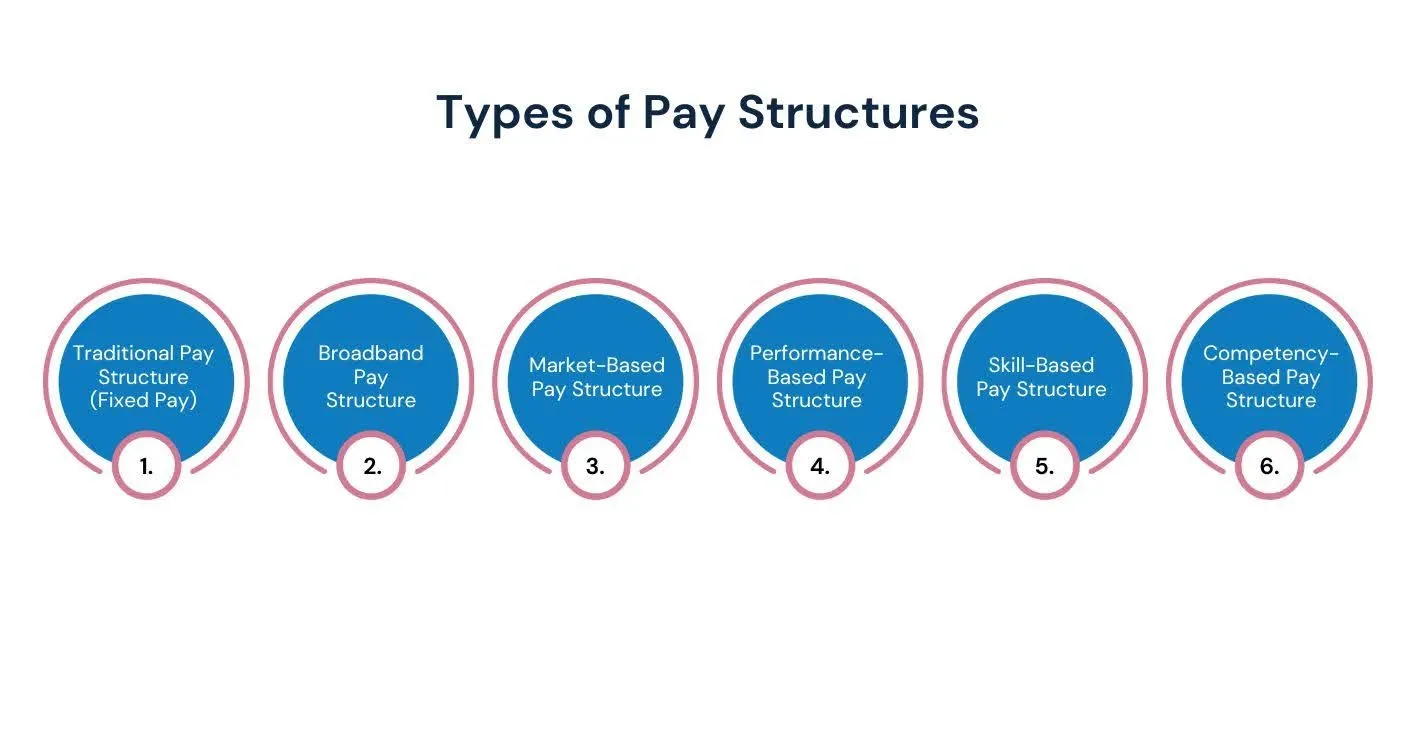
Pay grade structures and salary ranges are foundational elements in any organization’s compensation strategy. They provide a clear framework for setting employee pay based on job responsibilities, experience, and market trends.
What are the salary grades in your organization, and how do they align with job responsibilities? A well-defined pay structure ensures fairness, consistency, and competitiveness, which are essential for employee satisfaction and retention.
In this blog, we will explore the concept of pay grade structures and salary ranges, shedding light on how organizations set competitive and equitable compensation.
A pay grade structure is a system that organizes jobs into categories based on factors such as responsibilities, skills, and experience required. It creates a hierarchy that helps employers define how employees at different levels are compensated within the organization.
Typically, a pay grade structure groups jobs of similar value or responsibility, allowing companies to establish a consistent and organized approach to setting compensation. This helps avoid disparities and ensures that employees with similar roles and responsibilities are compensated equitably.
Pay grade structures also offer a clear pathway for career progression within the organization.
These structures can vary significantly from one organization to another, depending on the size of the company, industry standards, and specific job requirements. However, they all serve the same core purpose: to simplify the pay determination process, promote internal equity, and support talent management efforts.
Now that we have covered the basics of salary grades, let’s understand the importance of pay structures.
Suggested Read: Top 5 Pave Alternatives and Competitors in 2025
Pay structures are a fundamental part of any compensation system. They provide a framework that ensures consistency, fairness, and transparency in employee compensation.
Here's why pay structures are so important:
Pay structures provide a clear framework that supports the attraction and retention of top talent, aligns compensation with company goals, and simplifies financial planning. Understanding what the salary grades are can help employees gauge their potential career progression and pay growth.
Next, let’s learn more about the specifics of how pay grades work.
Suggested Read: Creating a Compensation Job Offer Letter: A Template Guide for Every Situation
Pay grades are structured hierarchically, with each grade representing a range of compensation for a specific level of responsibility, skill, and experience. The way these grades are established typically depends on factors like job evaluations, market research, and the company’s compensation philosophy.
Here's how pay grades generally work:
Pay grades are created by evaluating the job's responsibilities, required skills, and qualifications. Jobs with similar responsibilities and qualifications are grouped together within the same pay grade. This process ensures that jobs are categorized based on the value they bring to the organization.
Companies often perform market research to ensure that their pay grades are competitive. This means comparing compensation for similar roles within the industry and region. By understanding where their compensation stands in relation to the market, organizations can adjust their pay grades to remain competitive and attract top talent.
Pay grades also ensure that there is internal consistency. Employees at the same level in different departments or functions are compensated similarly, regardless of their specific role. This promotes fairness and prevents wage disparities within the organization.
The pay grades are typically arranged in a hierarchical order: entry-level jobs may fall under lower pay grades, mid-level jobs in higher grades, and senior or executive positions in the highest grades. Each pay grade has its own salary range, which is determined by factors like job scope and organizational budget.
Pay grades also provide employees with a clear understanding of their career progression. As employees gain experience and take on more responsibility, they can move up through the pay grades. This system not only incentivizes performance but also inculcates employee loyalty by showing them a clear path to salary growth.
Now that we have discussed pay grades and structures, let’s understand more about salary ranges.
Suggested Watch: This video explains the key concepts behind pay grades, salary ranges, and how they can be effectively implemented in organizations.
Salary ranges are the defined minimum, midpoint, and maximum compensation levels for a specific pay grade. These ranges provide flexibility and structure, ensuring that employees within the same pay grade are compensated according to their experience, skills, and market value.
Companies often set salary grades based on industry standards and internal job evaluations to ensure fairness and competitiveness.
Salary ranges consist of:
Salary ranges provide organizations with the flexibility to adjust pay within a specific range, allowing for considerations like performance, tenure, and market trends. They also help maintain internal equity by ensuring that compensation remains consistent across similar roles within the same pay grade.

CompUp provides tools to manage salary bands effectively, reinforcing pay transparency and fairness. This is a key theme explored in the podcast The Pay Equity Equation.
Now, let’s examine the key types of pay structures and their impact.

Organizations can implement various types of pay structures, each designed to meet specific business needs, market conditions, and workforce expectations. Here are some common types of pay structures:
In a traditional pay structure, employees within the same pay grade receive a fixed salary based on their position and job responsibilities. Salary increases are generally determined by tenure, performance, or annual reviews.
A broadband pay structure consolidates several pay grades into broader ranges, allowing employees more flexibility to grow within a range without requiring them to change grades frequently. It is commonly used in organizations with a flatter hierarchy or those focusing on career development.
This structure sets salaries based on market research, ensuring that compensation remains competitive with what similar companies pay for the same roles. Pay rates are adjusted regularly according to market trends and regional cost of living.
In this structure, compensation is tied to the performance of the individual or team. Bonuses, commissions, and raises are awarded based on how well employees meet or exceed performance targets.
Skill-based pay compensates employees for acquiring and demonstrating specific skills that are valuable to the company. Employees who gain additional certifications or mastery in certain skills receive higher pay.
This pay structure is based on the competencies employees demonstrate, including their knowledge, problem-solving abilities, and interpersonal skills. As employees develop new competencies, they can progress to higher pay bands.
Each type of pay structure has its pros and cons, and the choice of structure will depend on the organization's goals, industry standards, and workforce dynamics. Selecting the right pay structure is essential for balancing employee satisfaction, financial sustainability, and business objectives. Let’s explore key considerations for making the best choice.

From the Community: This Reddit thread discusses the challenges of setting up a compensation structure for a multi-location organization, particularly when wages vary by city and airport.
Selecting the right pay structure is a crucial decision that can significantly impact employee satisfaction, retention, and the overall effectiveness of your compensation strategy. The structure you choose should align with your organization's goals, culture, industry standards, and financial constraints.
If you are unsure about what the salary grades are, it's important to review the company's compensation structure. Here are the key factors to consider when choosing the best pay structure for your business:
By evaluating these factors, businesses can determine which pay structure best suits their needs, culture, and financial situation. Choosing the right structure ensures that compensation practices are aligned with business objectives, promote employee satisfaction, and contribute to long-term organizational success.
Suggested Read: Understanding On-Target Earnings (OTE) in Salary Calculations
CompUp is a powerful tool that helps HR teams simplify the management of pay grade structures and salary ranges. The platform ensures that organizations maintain a competitive edge while also offering fair compensation to their employees.
Key features of CompUp’s compensation management tool are:
These features help businesses simplify, optimize, and strengthen compensation strategies, ensuring workforce satisfaction and retention. A well-defined pay strategy strengthens workforce engagement and aligns compensation with organizational success.
Understanding and implementing effective pay grade structures and salary ranges is essential for building a fair, competitive, and transparent compensation system. These structures enable organizations to maintain internal equity while also attracting and retaining top talent.
CompUp offers powerful tools to help businesses manage these structures effectively. With features like Compensation Bands and Compensation Benchmarking, you can create well-defined salary ranges that align with industry standards and market trends.
Pay Transparency further enhances clarity by making sure that employees understand how their compensation is determined. Pay Equity helps identify and address any pay gaps, promoting fairness across the workforce.
Ready to optimize your compensation strategy? Schedule a free demo today to learn how CompUp can help you develop a fair and data-driven pay structure tailored to your organization's specific needs.
1. What are the differences between pay grades and pay ranges?
Pay grades categorize jobs into specific levels based on job responsibilities and requirements, while pay ranges define the minimum, midpoint, and maximum salary for each pay grade, offering flexibility in compensation within that grade.
2. What is the salary grade structure?
The salary grade structure organizes jobs into different levels, with each level having a corresponding pay grade. It ensures internal equity, aligns job roles with compensation, and provides clarity on career progression and salary expectations.
3. How to interpret salary ranges?
Salary ranges represent the minimum, midpoint, and maximum pay within a pay grade. The midpoint typically reflects market standards, while the minimum and maximum indicate starting and top-end compensation levels, providing flexibility for performance-based adjustments.
4. What are two disadvantages of a job-based pay structure?
Job-based pay structures can be inflexible, limiting compensation growth for high-performing employees, and they may not account for individual skill variations or market shifts, leading to potential talent retention issues or pay inequities.

Customer Success Manager - Team Lead
Led by a vision to transform the landscape of total rewards with an innovative mindset and technological advancements.
Revolutionizing Pay Strategies: Don't Miss Our Latest Blogs on Compensation Benchmarking